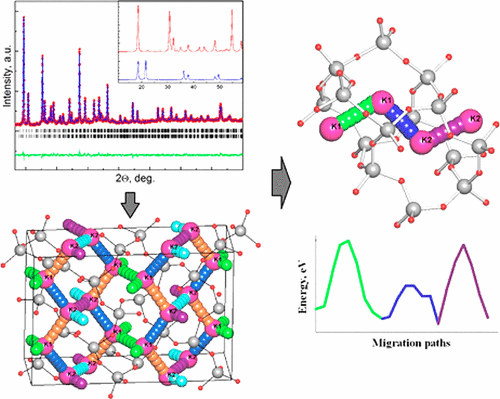当前位置:
X-MOL 学术
›
J. Phys. Chem. C
›
论文详情
Our official English website, www.x-mol.net, welcomes your
feedback! (Note: you will need to create a separate account there.)
Ionic Conductivity in Ti-Doped KFeO2: Experiment and Mathematical Modeling
The Journal of Physical Chemistry C ( IF 3.3 ) Pub Date : 2017-09-20 00:00:00 , DOI: 10.1021/acs.jpcc.7b05164 Natalia V. Proskurnina 1 , Vladimir I. Voronin 1 , Georgi Sh. Shekhtman 2 , Larisa N. Maskaeva 3 , Natalia A. Kabanova 4 , Artem A. Kabanov 4 , Vladislav A. Blatov 4, 5
The Journal of Physical Chemistry C ( IF 3.3 ) Pub Date : 2017-09-20 00:00:00 , DOI: 10.1021/acs.jpcc.7b05164 Natalia V. Proskurnina 1 , Vladimir I. Voronin 1 , Georgi Sh. Shekhtman 2 , Larisa N. Maskaeva 3 , Natalia A. Kabanova 4 , Artem A. Kabanov 4 , Vladislav A. Blatov 4, 5
Affiliation

|
The structure peculiarities of K0.9Fe0.9Ti0.1O2 that favor the emergence of a superionic state have been studied using neutron powder diffraction data as a function of temperature. The migration paths in the structure of both undoped and doped potassium ferrite were modeled by topological (tiling) and DFT methods. It is shown that heating of the low-temperature phase leads to increase of the ionic conductivity thanks to widening the migration channels and the appearance of thermally induced cation vacancies. The calculated migration barrier is found to not exceed 0.3 eV/ion in all phases, which is consistent with the experimental data. Doping also increases the ionic conductivity, but up to about 10% of Ti only; then the experimental activation energy even increases. The DFT modeling shows that it can be caused by growth of the regions unavailable for the mobile cations; the regions are formed around the dopant atoms.
中文翻译:

钛掺杂KFeO 2中的离子电导率:实验和数学建模
K 0.9 Fe 0.9 Ti 0.1 O 2的结构特征使用中子粉末衍射数据作为温度的函数,研究了有利于超离子态出现的方法。通过拓扑(平铺)和DFT方法对未掺杂和掺杂的铁酸钾结构中的迁移路径进行了建模。结果表明,低温相的加热导致离子电导率的增加,这是由于迁移通道变宽和热引发的阳离子空位的出现。发现计算出的迁移势垒在所有阶段均不超过0.3 eV /离子,这与实验数据一致。掺杂还增加了离子电导率,但仅占Ti的约10%。那么实验活化能甚至会增加。DFT模型表明,这可能是由于移动阳离子无法提供的区域的增长引起的。
更新日期:2017-09-20
中文翻译:

钛掺杂KFeO 2中的离子电导率:实验和数学建模
K 0.9 Fe 0.9 Ti 0.1 O 2的结构特征使用中子粉末衍射数据作为温度的函数,研究了有利于超离子态出现的方法。通过拓扑(平铺)和DFT方法对未掺杂和掺杂的铁酸钾结构中的迁移路径进行了建模。结果表明,低温相的加热导致离子电导率的增加,这是由于迁移通道变宽和热引发的阳离子空位的出现。发现计算出的迁移势垒在所有阶段均不超过0.3 eV /离子,这与实验数据一致。掺杂还增加了离子电导率,但仅占Ti的约10%。那么实验活化能甚至会增加。DFT模型表明,这可能是由于移动阳离子无法提供的区域的增长引起的。







































 京公网安备 11010802027423号
京公网安备 11010802027423号